
PAGE 2 — SP1G CONCRETE SAW • OPERATION MANUAL — REV. #4 (09/13/19)
PROPOSITION 65 WARNING

SP1G CONCRETE SAW • OPERATION MANUAL — REV. #4 (09/13/19) — PAGE 3
SILICOSIS WARNING
Grinding/cutting/drilling of masonry, concrete, metal and
other materials with silica in their composition may give
off dust or mists containing crystalline silica. Silica is a
basic component of sand, quartz, brick clay, granite and
numerous other minerals and rocks. Repeated and/or
substantial inhalation of airborne crystalline silica can
cause serious or fatal respiratory diseases, including
silicosis.In addition, California and some other
authorities have listed respirable crystalline silica as a
substance known to cause cancer. When cutting such
materials, always follow the respiratory precautions
mentioned above.
WARNING
Grinding/cutting/drilling of masonry, concrete, metal and
other materials can generate dust, mists and fumes
containing chemicals known to cause serious or fatal
injury or illness, such as respiratory disease, cancer,
birth defects or other reproductive harm. If you are
unfamiliar with the risks associated with the particular
process and/or material being cut or the composition of
the tool being used, review the material safety data
sheet and/or consult your employer, the material
manufacturer/supplier, governmental agencies such as
OSHA and NIOSH and other sources on hazardous
materials. California and some other authorities, for
instance, have published lists of substances known to
cause cancer, reproductive toxicity,or other harmful
effects.
Control dust, mist and fumes at the source where
possible. In this regard use good work practices and
follow the recommendations of the manufacturers or
suppliers, OSHA/NIOSH, and occupational and trade
associations.Water should be used for dust
suppression when wet cutting is feasible. When the
hazards from inhalation of dust, mists and fumes cannot
be eliminated, the operator and any bystanders should
always wear a respirator approved by NIOSH/MSHA for
the materials being used.
WARNING
SILICOSIS WARNING RESPIRATORY HAZARDS

PAGE 4 — SP1G CONCRETE SAW • OPERATION MANUAL — REV. #4 (09/13/19)
TABLE OF CONTENTS
SP1G Concrete Saw
Proposition 65 Warning ........................................... 2
Silicosis Warning ..................................................... 3
Table Of Contents .................................................... 4
Safety Information .............................................. 6-11
Specifications ................................................... 12-13
Dimensions ............................................................ 14
General Information ............................................... 15
Components ..................................................... 16-17
Basic Engine .......................................................... 18
Inspection ......................................................... 19-24
Operation .......................................................... 25-27
Maintenance ..................................................... 28-29
Troubleshooting ................................................ 30-32
NOTICE
Specifications are subject to change without notice.

SP1G CONCRETE SAW • OPERATION MANUAL — REV. #4 (09/13/19) — PAGE 5
NOTES

PAGE 6 — SP1G CONCRETE SAW • OPERATION MANUAL — REV. #4 (09/13/19)
SAFETY INFORMATION
Do not operate or service the equipment before reading
the entire manual. Safety precautions should be followed
at all times when operating this equipment.
Failure to read and understand the safety
messages and operating instructions could
result in injury to yourself and others.
SAFETY MESSAGES
The four safety messages shown below will inform you
about potential hazards that could injure you or others. The
safety messages specifi cally address the level of exposure
to the operator and are preceded by one of four words:
DANGER, WARNING, CAUTION
or NOTICE.
SAFETY SYMBOLS
DANGER
Indicates a hazardous situation which, if not avoided,
WILL result in DEATH or SERIOUS INJURY.
WARNING
Indicates a hazardous situation which, if not avoided,
COULD result in DEATH or SERIOUS INJURY.
CAUTION
Indicates a hazardous situation which, if not avoided,
COULD result in MINOR or MODERATE INJURY.
NOTICE
Addresses practices not related to personal injury.
Potential hazards associated with the operation of this
equipment will be referenced with hazard symbols which
may appear throughout this manual in conjunction with
safety messages.
Lethal exhaust gas hazards
Explosive fuel hazards
Burn hazards
Rotating parts hazards
Symbol Safety Hazard
Cutting and crushing hazards
Hydraulic fluid hazards

SP1G CONCRETE SAW • OPERATION MANUAL — REV. #4 (09/13/19) — PAGE 7
SAFETY INFORMATION
GENERAL SAFETY
WARNING
Adherence to the OSHA 2017 Ruling governing
Occupational Exposure to Respirable Crystalline Silica,
requires that all sawing operations MUST BE conducted
with High Effi ciency Particulate Air (HEPA) vacuum
system connected to the discharge port of the blade
guard.
CAUTION
NEVER operate this equipment without proper protective
clothing, shatterproof glasses, respiratory protection,
hearing protection, steel-toed boots and other protective
devices required by the job or city and state regulations.
Avoid wearing jewelry or loose fi tting clothes that may
snag on the controls or moving parts as this can cause
serious injury.
NEVER operate this equipment when not
feeling well due to fatigue, illness or when
under medication.
NEVER operate this equipment under the
infl uence of drugs or alcohol.
ALWAYS clear the work area of any debris, tools, etc.
that would constitute a hazard while the equipment is
in operation.
No one other than the operator is to be in the working
area when the equipment is in operation.
DO NOT use the equipment for any purpose other than
its intended purposes or applications.
NOTICE
This equipment should only be operated by trained and
qualifi ed personnel 18 years of age and older.
Whenever necessary, replace nameplate, operation and
safety decals when they become diffi cult read.
Manufacturer does not assume responsibility for any
accident due to equipment modifi cations. Unauthorized
equipment modifi cation will void all warranties.
NEVER
use accessories or attachments that are not
recommended by Multiquip for this equipment. Damage
to the equipment and/or injury to user may result.
ALWAYS know the location of the nearest
fi re extinguisher.
ALWAYS know the location of the nearest
fi rst aid kit.
ALWAYS know the location of the nearest phone or
keep
a phone on the job site.
Also, know the phone numbers
of the nearest ambulance, doctor and
fi re department.
This information will be invaluable in the case of an
emergency.

PAGE 8 — SP1G CONCRETE SAW • OPERATION MANUAL — REV. #4 (09/13/19)
SAFETY INFORMATION
SAW SAFETY
DANGER
Engine fuel exhaust gases contain poisonous carbon
monoxide. This gas is colorless and odorless, and can
cause death if inhaled.
The engine of this equipment requires an adequate free
fl ow of cooling air. NEVER operate this equipment in any
enclosed or narrow area
where free fl ow of the air is
restricted. If the air fl ow is
restricted it will cause injury
to people and property and
serious damage to the
equipment or engine.
NEVER operate the equipment in an explosive
atmosphere or near combustible materials. An
explosion or fi re could result causing severe
bodily harm or even death.
WARNING
If applicable, NEVER use your hand to fi nd
hydraulic leaks. Use a piece of wood or
cardboard. Hydraulic fl uid injected into the
skin must be treated by a knowledgeable
physician immediately or severe injury or
death can occur.
Accidental starting can cause severe injury
or death. ALWAYS place the ON/OFF
switch in the OFF position.
NEVER disconnect any emergency or safety devices.
These devices are intended for operator safety.
Disconnection of these devices can cause severe injury,
bodily harm or even death. Disconnection of any of these
devices will void all warranties.
CAUTION
Anytime the saw is lifted onto its nose or tilted fully
back, such as for maintenance access, the high end of
the saw MUST be blocked up to prevent the possibility
of crush injury.
DANGEROUS
GAS FUMES
NOTICE
ALWAYS ensure saw is securely
placed on appropriate
blocks or jackstands when performing maintenance that
requires elevation of the saw.
If saw has brakes, ensure brakes are applied when
leaving or when using on a slope. Some saws utilize a
brake system where the brakes are automatically applied
when the engine is stopped.
If saw has a parking brake, ensure that the parking brake
is engaged and holds the saw safely in place when
parking on a slope. Turning the saw across the angle of
the slope will help prevent accidental downhill movement.
ALWAYS
block the saw with appropriate blocks when
leaving the saw parked on a slope.
To prevent unexpected loss of control, DO NOT
start
engine on a sloping surface.
DO NOT
use on excessive slopes or on extremely
uneven surfaces.
ALWAYS keep the machine in proper running condition.
Fix damage to machine and replace any broken parts
immediately.
Make sure there is no buildup of concrete, grease, oil or
debris on the machine.
ALWAYS
store equipment properly when it is not being
used. Equipment should be stored in a clean, dry location
out of the reach of children and unauthorized personnel.

SP1G CONCRETE SAW • OPERATION MANUAL — REV. #4 (09/13/19) — PAGE 9
SAFETY INFORMATION
BLADE SAFETY
WARNING
Rotating blade can cut and crush. ALWAYS
keep hands and feet clear while operating
the saw.
CAUTION
NEVER operate the saw without blade
guards and covers in place. Exposure of
the diamond blade must not exceed 180
degrees.
Verify the engine start switch is set to the OFF position
before installing a blade.
ALWAYS inspect blade before each
use. The blade should exhibit no cracks,
dings, or fl aws in the steel centered core
and/or rim. Center (arbor) hole must be
undamaged and true.
NOTICE
Use proper diamond blades and follow blade
manufacturer’s recommendations.
Ensure the 5/8" blade-mounting bolt is tightened to 45-50
foot lbs. of torque.
ALWAYS examine blade flanges for damage and
excessive wear.
Only cut the material that is specifi ed for the diamond
blade. Read the specifi cation of the diamond blade to
ensure the proper tool has been matched to the material
being cut.
DO NOT drop the diamond blade on ground or surface.
Ensure that the blade is mounted for proper operating
direction (upcut).
Adhere to the blade manufacturer’s recommendations
on handling, storage and safe usage of blades.
ENGINE SAFETY
WARNING
DO NOT place hands or fingers inside
engine compartment when engine is
running.
NEVER
operate the engine with heat shields or
guards removed.
Keep fi ngers, hands hair and clothing away
from all moving parts to prevent injury.
ALWAYS shut down the engine before
performing service or maintenance.
DO NOT
remove the engine oil drain plug while the
engine is hot. Hot oil will gush out of the oil tank and
severely scald any persons in the general area of the
saw.
CAUTION
NEVER touch the hot exhaust manifold,
muffl er or cylinder. Allow these parts to cool
before servicing equipment.
Make certain the operator knows how to and is capable
of turning the engine OFF in case of an emergency.
NOTICE
NEVER
run engine without an air fi lter or with a dirty air
fi lter. Severe engine damage may occur. Service air fi lter
frequently to prevent engine malfunction.
NEVER tamper with the factory settings
of the engine or engine governor. Damage
to the engine or equipment can result
if operating in speed ranges above the
maximum allowable.

PAGE 10 — SP1G CONCRETE SAW • OPERATION MANUAL — REV. #4 (09/13/19)
SAFETY INFORMATION
FUEL SAFETY
DANGER
DO NOT add fuel to equipment if it is placed inside truck
bed with plastic liner. Possibility exists of explosion or
fi re due to static electricity
DO NOT start the engine near spilled fuel or combustible
fl uids. Fuel is extremely fl ammable and its vapors can
cause an explosion if ignited.
ALWAYS refuel in a well-ventilated area, away from
sparks and open fl ames.
ALWAYS use extreme caution when working with
fl ammable liquids.
DO NOT fi ll the fuel tank while the engine is running
or hot.
DO NOT overfi ll tank, since spilled fuel could ignite if it
comes into contact with hot engine parts or sparks from
the ignition system.
Store fuel in appropriate containers, in well-ventilated
areas and away from sparks and fl ames.
NEVER use fuel as a cleaning agent.
DO NOT smoke around or near the
equipment. Fire or explosion could result
from fuel vapors or if fuel is spilled on a
hot engine.
FUEL
FUEL
LIFTING SAFETY
CAUTION
NEVER
allow any person or animal to stand underneath
the equipment while lifting.
Some saws are very heavy and awkward to move around.
Use proper heavy lifting procedures.
DO NOT
attempt to lift the saw by the guards or front
pointers.
NOTICE
For lifting the saw, a lifting handle in the front of the unit and
grasp points towards the rear of the frame are provided. It
is recommended that two persons lift the saw.
NEVER
tip the engine to extreme angles during lifting as
it may cause oil to gravitate into the cylinder head, making
the engine start diffi cult.
DO NOT lift machine to unnecessary heights.
NEVER lift the equipment while the engine is running.
ALWAYS
use ramps capable of supporting the weight of
the saw and the operator to load and unload the saw.
TRANSPORTING SAFETY
NOTICE
ALWAYS shut down engine before transporting.
Tighten fuel tank cap securely and close fuel cock to
prevent fuel from spilling.
ALWAYS
tie down equipment during transport by
securing the equipment with rope.
Ensure that the diamond blade does not come into contact
with the ground or surface during transportation.
NEVER
transport the saw to or from the job site with the
blade mounted.

SP1G CONCRETE SAW • OPERATION MANUAL — REV. #4 (09/13/19) — PAGE 11
SAFETY INFORMATION
ENVIRONMENTAL SAFETY/DECOMMISSIONING
NOTICE
Decommissioning is a controlled process used to safely
retire a piece of equipment that is no longer serviceable.
If the equipment poses an unacceptable and unrepairable
safety risk due to wear or damage or is no longer cost
effective to maintain (beyond life-cycle reliability) and is to
be decommissioned (demolition and dismantlement),be
sure to follow rules below.
DO NOT pour waste or oil directly onto the ground, down
a drain or into any water source.
Contact your country's Department of
Public Works or recycling agency in your
area and arrange for proper disposal of
any electrical components, waste or oil
associated with this equipment.
When the life cycle of this equipment is over, remove
battery and bring to appropriate facility for lead
reclamation. Use safety precautions when handling
batteries that contain sulfuric acid.
When the life cycle of this equipment is over, it is
recommended that the trowel frame and all other metal
parts be sent to a recycling center.
Metal recycling involves the collection of metal from
discarded products and its transformation into raw
materials to use in manufacturing a new product.
Recyclers and manufacturers alike promote the process
of recycling metal. Using a metal recycling center
promotes energy cost savings.
EMISSIONS INFORMATION
NOTICE
The gasoline engine used in this equipment has been
designed to reduce harmful levels of carbon monoxide
(CO), hydrocarbons (HC) and nitrogen oxides (NOx)
contained in gasoline exhaust emissions.
This engine has been certifi ed to meet US EPA Evaporative
emissions requirements in the installed confi guration.
Attempting to modify or make adjustments to the engine
emission system by unauthorized personnel without proper
training could damage the equipment or create an unsafe
condition.
Additionally, modifying the fuel system may adversely affect
evaporative emissions, resulting in fi nes or other penalties.
Emission Control Label
The emission control label is an integral part of the emission
system and is strictly controlled by regulations.
The label must remain with the engine for its entire life.
If a replacement emission label is needed, please contact
your authorized Honda Engine Distributor.
SILICA INFORMATION
WARNING
Adherence to the OSHA 2017 Ruling governing
Occupational Exposure to Respirable Crystalline Silica,
requires that all sawing operations MUST BE
conducted
with High Effi ciency Particulate Air (HEPA) vacuum
system connected to the discharge port of the blade
guard.

PAGE 12 — SP1G CONCRETE SAW • OPERATION MANUAL — REV. #4 (09/13/19)
SPECIFICATIONS
Table 1. Specifications (Saw)
Arbor Size 5/8 in. (15.87 mm)
Blade Capacity 10 in. (254 mm)
Sawing Orientation Upcut
Cutting Depth 3.25 in. (82.6 mm)
Front and Rear Wheels 5 x 1.5 in (127 x 38 mm)
Nominal Mass* 105 lb. (47.6 Kg)
Maximum Operating Mass** 113 lb. (51 Kg)
* Without blade, all fluid tanks empty, any optional
parts removed.
** Includes blade, all fluid tanks full, any necessary components
installed
Table 2. Specifications (Engine)
Model HONDA GX200UT2QXC9
Type
Air-cooled 4 stroke, Single Cylinder, OHV, Gasoline
Engine
Bore X Stroke
2.7 in. X 2.1 in.
(68 mm x 54 mm)
Displacement 12.0 cu-in. (196 cc)
Max Output
6.4 H.P./3600 R.P.M.
(4.8 kW, 6.5 PS)
Fuel Tank Capacity
Approx. 0.95 U.S. Gallons
(3.6 Liters)
Fuel
Unleaded Automobile Gasoline
86 Octane or higher
Lube Oil Capacity 0.63 US qt (0.60 liter)
Speed Control Method Centrifugal Flyweight Type
Starting Method Recoil Start
Dimension (L x W x H)
12.3 x 14.8 X 13.2 in.
(313 X 376 X 335 mm)
Dry Net Weight 35.3 lbs (16 Kg.)

SP1G CONCRETE SAW • OPERATION MANUAL — REV. #4 (09/13/19) — PAGE 13
SPECIFICATIONS
NOTES:
1. Sound Pressure and Power Levels are “A” weighted Measures per ISO 3744:2010. They are measured with the operating condition of the
machine which generates the most repeatable but highest values of the sound levels. Under normal circumstances, the sound level will vary
depending on the condition of the material being worked upon.
2. The vibration level indicated is the vector sum of the RMS (Root Mean Square) Values of amplitudes on each axis, standardized to an 8 hour
exposure period, and obtained using operating condition of the machine that generates the most repeatable but highest values in accordance
with the applicable standards for the machine.
3. Per EU Directive 2002/44/EC, the daily exposure action value for hand/arm vibration is 2.5 m/s
2
∑A(8). The daily exposure limit value is
5 m/s
2
∑A(8).
Table 3. Noise and Vibration Emissions
Guaranteed ISO 11201:2010 Based
Sound Pressure Level at Operator Station in dB(A)
95
Guaranteed ISO 3744:2010 Based
Sound Power Level in dB(A)
126
Hand-Arm Vibration Per ISO 5349-1:2001
in m/s
2
∑A(8).
0.52

PAGE 14 — SP1G CONCRETE SAW • OPERATION MANUAL — REV. #4 (09/13/19)
DIMENSIONS
A
B
SIDE VIEW
FRONT VIEW
C
D
E
G
F
Table 4. Dimensions
REFERENCE DESCRIPTION DIMENSION
A Max Height (Handle Bars Fully Raised) 13 in (330 mm)
B Max Height (Handle Bars Fully Lowered) 26.5 in (673.1 mm)
C
Max Length (Handle Bars Fully Raised & Front
Pointer Lowered)
34 in (864 mm)
D
Max Length (Handle Bars Fully Raised & Front
Pointer Raised)
46 in (1168.4 mm)
E
Max Length (Handle Bars Fully Lowered & Front
Pointer Raised)
43 in (1092.2 mm)
F Max Overall Width 41 in (1041 mm)
G Max Handle Bar Deflection 14 in (355.6 mm)
Figure 1. SP1G Dimensions

SP1G CONCRETE SAW • OPERATION MANUAL — REV. #4 (09/13/19) — PAGE 15
GENERAL INFORMATION
INTENDED USE
Operate the SP1G Saw, tools and components in
accordance with the manufacturer's instructions. Use of
any other tools for stated operation is considered contrary
to designated use. The risk of such use lies entirely with the
user. The manufacturer cannot be held liable for damages
as a result of misuse.
This saw is not intended for wet cutting (the use of water
sprayed onto the blade during sawing operations). The use
of a High Efficiency Particulate Air (HEPA) dust collector
must be attached to the blade guard discharge port during
operations.
FAMILIARIZATION
This lightweight, compact, and productive saw is designed
for dry sawing of concrete slabs utilizing diamond blades.
The saw has been engineered for general and industrial
flat sawing applications that include: Joint Sawing of Green
Concrete, Decorative Sawing in Cured Concrete, Light
Demolition Sawing and "V" Groove Beveling. The simple
and compact nature of the saw makes it a perfect sawing
tool for one person to operate and transport. The saw
combines innovative features, top quality components, and
a committed attention to state-of-the-art manufacturing.
For peak performance, the saw has been engineered to
operate with a powerful 5.5 HP Honda gasoline engine
with Cyclone Air Filtration. It includes a 10-inch diameter,
green concrete diamond blade. The green concrete blade
allows for fast and clean cuts in concrete recently poured
(4 to 12 hours) at depths from 1/4 inch to 3 1/4 inches.
The precision-machined, reinforced cast frame and steel
chassis assembly are designed to eliminate operational
bending and/or flex that would lead to diminished blade
performance. Also, the frame's general weight-to-strength
ratio and center mounted blade design ensure accurate
tracking in the cut.
A robust blade shaft bearing assembly ensures minimal
flutter and shaft harmonics providing the most advantageous
conditions for a diamond blade at operating speeds.
Heavy-duty front and rear axles, synthetic neoprene wheels
with permanently sealed bearings that are greaseable, and
solid undercarriage assembly, provide years of reliable use.
The SP1G incorporates an innovative posi-lock raise/lower
system that provides precise control of blade orientation.
This system further allows for infinitely adjusting blade
depth control and depth gauge.
The SP1G has a unique front pointer bar that ensures
optimum sawing accuracy. For operator comfort and ease
of transportation and storage, an adjustable locking handle
bar with vibration damping is provided. It also has a lifting
handle for ease of transportation.
Operator control of the saws is safely accomplished with
adjustable handle bars, and a conveniently oriented raise/
lower lever and depth adjustment lever. A shut-off switch
is located next to the handle lock allows the operator to
safely turn the engine off from the operator's position and
away from moving parts.
For maximum performance and return on investment, use
Multiquip Diamond Blades.

PAGE 16 — SP1G CONCRETE SAW • OPERATION MANUAL — REV. #4 (09/13/19)
COMPONENTS
Figure 2. SP1G Components
2
28
4
25
23
11
12
3
22
27
16
10
20
13
7
1
5
9
26
14
8
17
24
15
19
6
21
18

SP1G CONCRETE SAW • OPERATION MANUAL — REV. #4 (09/13/19) — PAGE 17
COMPONENTS
Figure 2 shows the location of the basic components for
the SP1G concrete saw. Listed below is a brief explanation
of each component.
1. Hand Grips/Handlebar — When operating the saw,
place both hands on each grip to maneuver the saw.
2. Adjustable Handle — Set to comfortable operating
position.
3. Rear Pointer Guide — Provides rear start orientation
to the snap line.
4. Air Filter — Prevents dirt and debris from entering
the engine air intake. Keep cleaned and replace when
necessary.
5. Recoil Starter Handle — Pull to engage and start
the engine.
6. Recoil Starter Assembly — Engages the engine when
the handle is pulled and rewinds the starter rope when
the handle is released.
7. Wheels/Carriage Assembly — Heavy-duty synthetic
neoprene wheels with permanently sealed ball
bearings.
8. Diamond Blade — 5/8-inch (15.87 mm) arbor diameter
and 10-inch blade capacity. The 10-inch diameter
provides for 1/4 to 3 1/4-inch depth of cut.
9. Blade Guard — Covers saw blade and flips up to allow
blade to be changed.
10. Belt Tension Adjuster — Adjusts belt tension.
11. Front Pointer — Assists in straight tracking.
12. Front Pointer Arm — Pivots up for storage and pivots
down for use.
13. Depth Adjust Knob — Turn knob to establish preferred
blade depth.
14. Fuel Tank — Uses unleaded gasoline. Do not overfill.
15. Depth Control Handle — A single throw raise/lower
lever.
16. V-Belt Cover — Remove this cover to gain access
to the V-belt. NEVER operate the saw with this cover
removed.
17. Arbor Shaft Grease Zerk — Conveniently located
for lubrication.
18. On/Off Switch (Engine) — Turn to the ON position to
allow engine to be started and turn to the OFF position
to prevent accidental starting.
19. Handle Lock — Locks handle height to a comfortable
operating position.
20. Depth Stop Rod — Holds blade above working surface
or allows blade to cut into working surface at specified
depth.
21. Shut-off Switch — Located next to the handle lock,
serves both as an Emergency Engine Shut-Off and as
the primary Shutdown switch. This allows the operator
to shutdown the saw safely away from moving parts.
22. Dust Discharge Port — Allows dust evacuation and
connection point to a vacuum system.
23. Front Pointer Cable — Allows for raise/lower of front
pointer assembly.
24. Lifting Handle — Provides lift point hand hold.
25. Blade Removal Tool — Wrench for blade locking and
blade guard fasteners.
26. Blade Shaft Locking Pin — Locks blade shaft for
blade nut removal.
27. Depth Pointer — Points to blade depth against the
ruler guide.
28. Ruler Guide — Shows depth graduation.

PAGE 18 — SP1G CONCRETE SAW • OPERATION MANUAL — REV. #4 (09/13/19)
BASIC ENGINE
Figure 3. Engine Components
INITIAL SERVICING
The engine (Figure 3) must be checked for proper
lubrication and filled with fuel prior to operation. Refer to
the manufacturer's engine manual for detailed operation
and service instructions.
1. Throttle Lever — Adjusts engine RPM speed.
2. Fuel Filler Cap — Remove to add unleaded gasoline
to the fuel tank. Make sure cap is tightened securely.
DO NOT overfill.
3. Fuel Tank — Holds unleaded gasoline. Refer to
the manufacturer's engine manual for additional
information.
4. Engine ON/OFF Switch — ON position permits engine
starting, OFF position stops engine operation.
2
12
11
1
4
3
10
9
8
7
6
5
DANGER
DO NOT fill the fuel tank while the engine
is running or hot. In the event of a fuel
spill, DO NOT start the engine until all
fuel residue has been wiped up and the
area surrounding the engine is dry. Fuel
is extremely flammable and can ignite if
it comes into contact with hot engine parts
or sparks from the ignition system.
5. Recoil Starter — Manual starting mechanism. Slowly
pull the starter grip until resistance is felt, then pull
briskly and smoothly to start the engine.
6. Fuel Valve Lever — Open to allow the flow of fuel, and
close to prevent the flow of fuel.
7. Oil Drain Plug — Remove to drain oil from the engine
crankcase.
8. Dipstick/Oil Filler Cap — Remove to determine
if engine oil is low. Add oil through this port as
recommended in Table 6.
9. Choke Lever — Aids in starting a cold engine, or
starting in cold weather conditions. The choke enriches
the fuel mixture.
10. Spark Plug — Provides spark to the ignition system.
Set the spark plug gap according to the engine
manufacturer's instructions, and clean the spark plug
once a week.
11. Muffler — Reduces noise and emissions. NEVER
touch the muffler while it is hot.
12. Air Cleaner — Prevents dirt and other debris from
entering the fuel system. Remove the wing nut on top
of the air cleaner to gain access to the filter elements.
CAUTION
NEVER disable or disconnect the engine ON/OFF
switch. It is provided for operator safety. Injury may
result if it is disabled, disconnected, or improperly
maintained.
WARNING
Engine components can generate extreme
heat. To prevent burns, DO NOT touch
these areas while the engine is running
or immediately after operating. NEVER
operate the engine with the muffler
removed.
NOTICE
Operating the engine without an air filter, or with a
damaged or worn air filter in need of replacement, will
allow dirt to enter the engine, causing rapid engine
wear.

SP1G CONCRETE SAW • OPERATION MANUAL — REV. #4 (09/13/19) — PAGE 19
INSPECTION
BLADE GUARD
Figure 4. Blade Guard
Check the following on the blade guard (Figure 4):
Ensure the capacity of the blade guard matches the
diameter of your diamond blade.
Check that the guard is bolted firmly upon the saw frame.
V-BELT CHECK
A worn or damaged V-belt can adversely affect the
performance of the saw. If the V-belt is defective or worn,
replace the V-belt as outlined in the maintenance section.
WARNING
NEVER operate the saw without blade
guards and covers in place. DO NOT
operate with the front of the blade guard
raised. The blade exposure cannot exceed
180 degrees during operation. Adhere to the
safety guidelines of the American National
Standards Institute (ANSI) B7.1 and B7.5.
CAUTION
NEVER attempt to check the V-belt with the
engine running. Severe injury can occur.
Keep fingers, hands, hair and clothing
away from all moving parts.
V-belt Alignment and Tensioning
This concrete saw is equipped with a premium V-belt that
has been aligned and tensioned by factory personnel. The
V-belt must be aligned and tensioned for proper operation
of the saw.
Use the following procedure to check the alignment of
V-belt:
1. Remove the bolts that secure the V-belt cover (Figure 5)
to the saw frame.
Figure 5. V-Belt Cover
2. Check uniform parallelism (Figure 6) of V-belt and
pulley (sheaves). Use a straight-edge or machinist's
square against both pulleys and adjust both pulleys
until equally aligned.
Figure 6. Pulley Alignment
3. Check V-belt tension by using a tension meter
(6.0 – 9.0 lbs.) against the inside belt at a mid point
between the two pulleys, or by deflecting the center
belt at a mid point 3/8" (10 mm) to 1/2" (13 mm). See
Figure 7.

PAGE 20 — SP1G CONCRETE SAW • OPERATION MANUAL — REV. #4 (09/13/19)
INSPECTION
Figure 7. V-Belt Tension Check
4. DO NOT overtighten or undertighten the V-belt. Severe
damage can occur to the saw and engine crankshaft
if the belt is over-tensioned. A decrease of power to
the blade and poor performance will result if the belt
is under-tensioned (loose on pulleys).
V-belt Tightening
Figure 8. V-Belt Tension Adjustment
1. With V-belt guard removed, loosen the 4 engine
mounting hex screws (Figure 8).
2. Loosen the locking nut and jam nut on the V-belt tension
adjuster.
NOTICE
V-belt alignment must be rechecked after adjusting
belt tension.
ENGINE
MOUNTING
HEX SCREWS
JAM NUT
LOCKING NUT
ADJUSTING
HEX
SCREW
3. Tighten the adjusting hex screw while holding the
engine in place to maintain pulley alignment. A
screwdriver can be used as a lever at the rear belt
guard mounting boss to hold the back of the engine
while adjusting V-belt tension.
4. Retighten the locking nut and jam nut.
5. With V-belt held in proper alignment (engine parallel
with the frame), retighten the 4 engine mounting
hex screws. Verify that all hex screws are properly
tightened.
V-belt Removal and Replacement
If the V-belt becomes worn or damaged, replace it with
new one.
1. Remove the 3 hex screws holding the V-belt guard and
remove the guard.
2. Loosen the 4 engine mounting hex screws (Figure 8).
3. Loosen locking nut on the V-belt tension adjuster.
4. Loosen the tension on the V-belt by turning the tension
adjuster hex screw.
5. Push the engine forward to provide slack in the V-belt.
6. Remove the belt from the main engine pulley.
7. Remove the two arbor shaft hex screws allowing the
outside of the shaft to drop (Figure 9).
8. Remove the V-belt.
Figure 9. V-Belt Removal
9. Reinstall new V-belt.
10. Reinstall and tighten arbor shaft hex screws.
11. With V-belt held in proper alignment, retighten the 4
engine mounting hex screws. (Follow V-belt Tightening
procedure.)
12. Reinstall belt guard with 3 hex screws.
ARBOR SHAFT
HEX SCREW
ARBOR
SHAFT
Page is loading ...
Page is loading ...
Page is loading ...
Page is loading ...
Page is loading ...
Page is loading ...
Page is loading ...
Page is loading ...
Page is loading ...
Page is loading ...
Page is loading ...
Page is loading ...
Page is loading ...
Page is loading ...
-
 1
1
-
 2
2
-
 3
3
-
 4
4
-
 5
5
-
 6
6
-
 7
7
-
 8
8
-
 9
9
-
 10
10
-
 11
11
-
 12
12
-
 13
13
-
 14
14
-
 15
15
-
 16
16
-
 17
17
-
 18
18
-
 19
19
-
 20
20
-
 21
21
-
 22
22
-
 23
23
-
 24
24
-
 25
25
-
 26
26
-
 27
27
-
 28
28
-
 29
29
-
 30
30
-
 31
31
-
 32
32
-
 33
33
-
 34
34
Ask a question and I''ll find the answer in the document
Finding information in a document is now easier with AI
Related papers
-
MQ Multiquip Saw HS62A User manual
-
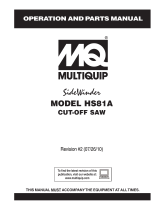 MQ Multiquip HS81A User manual
MQ Multiquip HS81A User manual
-
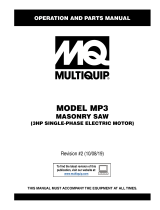 MQ Multiquip MP3 Operating instructions
MQ Multiquip MP3 Operating instructions
-
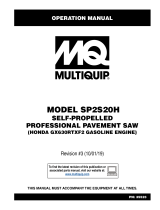 MQ Multiquip SP2S20H Operating instructions
MQ Multiquip SP2S20H Operating instructions
-
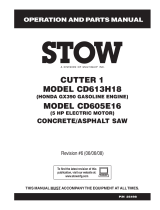 MQ Multiquip CUTTER1-SERIES User manual
MQ Multiquip CUTTER1-SERIES User manual
-
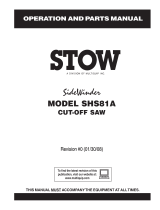 MQ Multiquip SHS81A User manual
MQ Multiquip SHS81A User manual
-
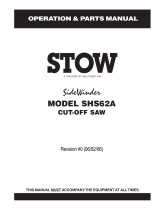 MQ Multiquip SHS62A User manual
MQ Multiquip SHS62A User manual
-
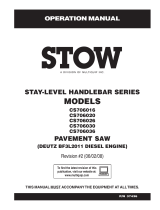 MQ Multiquip CS7060-series Operating instructions
MQ Multiquip CS7060-series Operating instructions
-
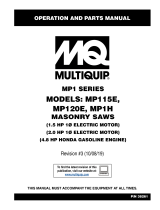 MQ Multiquip MP1H-115E-120E Operating instructions
MQ Multiquip MP1H-115E-120E Operating instructions
-
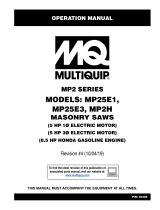 MQ Multiquip MP2-SERIES Operating instructions
MQ Multiquip MP2-SERIES Operating instructions
Other documents
-
Draper NEW 245mm Bandsaw Operating instructions
-
Draper NEW Bandsaw, 228mm, 300W Operating instructions
-
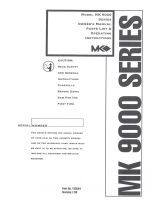 MK Diamond Products MK-9000 Owner's manual
MK Diamond Products MK-9000 Owner's manual
-
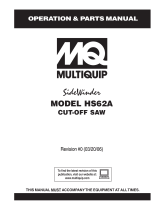 MULTIQUIP Saw HS62A User manual
MULTIQUIP Saw HS62A User manual
-
Diamond CC3500 User manual
-
Stark 61057-H User manual
-
Husqvarna FS 413 User manual
-
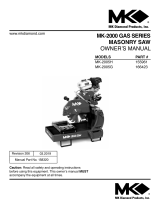 MK Diamond Products MK-2000 Gas Saws Owner's manual
MK Diamond Products MK-2000 Gas Saws Owner's manual
-
Husqvarna Welder FS 413 User manual
-
Husqvarna FS 413 User manual














































